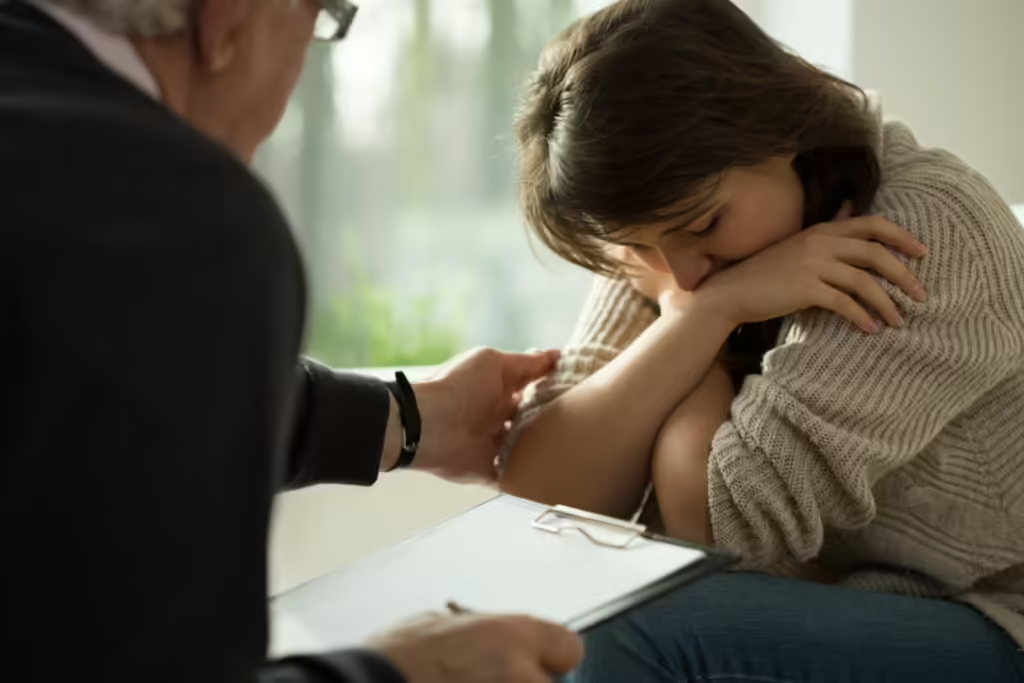What Does PTSD Look Like?

Anyone who experiences a traumatic event can potentially develop post-traumatic stress disorder, or PTSD.
PTSD manifests itself in different ways in the different people it affects. While there isn’t necessarily a “cure” for PTSD, there are countless treatment techniques and facilities geared towards relieving the symptoms and complications of PTSD.
What is PTSD?
Post-traumatic stress disorder is exactly what it sounds like – a mental health condition that can arise when you live through a traumatic event.
Some examples of traumatic events include:
- Natural disasters, like a tornado, hurricane or fire
- Car accidents
- Being the victim of physical or verbal bullying, harassment or abuse
- Involvement in a hostage or kidnapping situation
- Experiencing violence, including military violence, terrorism or assault
- Witnessing violence, even if you’re not directly harmed or involved
- Work that involves fearful, dangerous or stressful situations, such as a first responder position
- Undergoing a traumatic childbirth, or witnessing your partner give birth under traumatic circumstances
- Losing a loved one, especially suddenly
A traumatic event doesn’t necessarily have to be a one-time incident. PTSD can also arise after repeated exposure to highly stressful or terrifying situations. For instance, victims of domestic abuse can develop PTSD.
Not everyone who undergoes a traumatic event will suffer from PTSD. Additionally, it’s possible to develop PTSD even if you were not directly involved in the event. Hearing about the traumatic experience of a loved one can cause close relatives or friends to suffer from PTSD as well.
There are a variety of factors that can determine whether or not a person will go on to develop PTSD. These factors include the specific details of the traumatic event or even genetics (some people might be more biologically disposed to PTSD than others).
What are possible PTSD signs and symptoms?
Every case of PTSD looks different depending on the individual’s unique experiences and mental health history. However, in order to meet the diagnostic criteria for PTSD, an individual will have experienced several types of symptoms for at least one month. These symptoms fall into four categories: re-experiencing, avoidance, arousal/reactivity and cognition/mood.
Reliving or re-experiencing the traumatic event
A person who has experienced trauma may relive or re-experience the event. Re-experiencing symptoms can disrupt one’s daily routine and may include the following:
- Nightmares
- Flashbacks
- Recurring thoughts about the event
- Physical symptoms related to this reliving, including racing heart, sweating and signs of stress
Anything can trigger the brain to relive the event. For example, a driver quickly hitting the brakes may cause an individual to flash back to a previously traumatic car accident, or a severe thunderstorm could cause nightmares about a past natural disaster.
Agitation or edginess
PTSD symptoms may begin to negatively interfere with daily life by interrupting sleep or concentration. You may notice signs of hyperarousal, such as:
- Angry or irritable outbursts
- Being easily startled
- Seemingly tense or on guard
- Behavior that is reckless, dangerous or careless
- Insomnia or difficulty sleeping
This can come from a (conscious or subconscious) sense of self-preservation against any potential future danger or trauma.
Changes in mood or cognition
Moods and thought patterns change, sometimes in undesirable ways, as a result of trauma and its effects on the brain.
Examples of PTSD-related cognitive or mood changes include:
- Blaming oneself for the event or for not doing something to prevent it from happening
- A lack of positive emotions like joy, happiness or peace
- A higher presence of negative emotions like shame, guilt and/or fear
- Difficulty remembering certain parts of the traumatic event
It’s normal for anyone to experience mood changes following a traumatic event, but with PTSD, these symptoms last more than a month and interfere with daily functioning.
Avoidance
Another means of self-preservation, some individuals stay away from people, places or situations which may bring up thoughts or memories of the trauma. Examples of avoidance behaviors are as follows:
- Withdrawal from social events
- Loss of desire to partake in previously enjoyed hobbies
- Staying away from people or places connected to the trauma
- Trying to always keep busy to avoid intrusive thoughts
Avoidance behaviors may cause noticeable changes in routine, from moving out of an apartment you shared with an abusive partner to refusing to drive in a car following an accident.
Raising awareness for PTSD
One key way you can help your loved one suffering from PTSD is through educating yourself about PTSD signs and symptoms and the various options for treatment. The more you yourself know about the mental illness, the more you can advocate for your loved one’s treatment, in addition to encouraging behaviors and habits to promote healing and mental health awareness.
For more information on PTSD, or to learn more about personalized treatment plans for PTSD, contact Silvermist Recovery. Call our offices at (412) 561-9558 or fill out the form on our website to get started.






